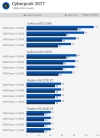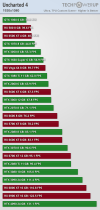I'm assuming this is your question? It's incorrectly quoted as me in the post above. As noted by
@Below2D we know it's GPU limited in fidelity mode because we know that as resolution (which impacts GPU and not CPU performance) is decreased, the framerate increases significantly. If it were CPU bound at 4k in fidelity mode then decreasing resolution for the various performance modes would have no impact on the framerate.
I got what you are saying:
The CPU manages the frame rate, so increasing the framerate will have impact on the CPU.
What you are saying is basically that. Because if we were CPU bounded, then in fidelity mode we could not increase fps, even by reducing resolution.
Because more fps requires more CPU and if we were bounded there would be nothing to spare!
Ok, this is logic! I see the point...
But regardless of that, look at these benchmarks:

Looking at the 5600 and 5700xt, we see we are GPU bounded.
But on the other cases we are CPU bounded.
Taking the 3090 as example, all CPUs above the 2600X have the performance for 60 fps at 1080p. Just like the PS4 CPU has the performance for 60 fps at 1440!
But does that means we are seeing the full power of the GPU?
No, if we improve the CPU, we get better results?
So, although the logic is sane, it does not answer my question: How do we know what is the GPU equivalent of the PS5 without using an equivalent CPU? Who guarantees us that with a better CPU the PS5 GPU would not fair better?
Due to this, I believe that the only way to see what an equivalent GPU to the one in PS5 is, is to place a similar CPU on a PC, and replace the GPU until we find one that in equal circumstances gives the same results.
Look at this example: PS 5 would be the Ryzen 5 1600x with a 3090.
And you test a PC with a 3070 and a Ryzen 5 5600x.
You would get better results... And then claim the PS5 GPU is bellow te 3070. When in reality, in this example, is a 3090.
See my point? And all because of the CPU.



